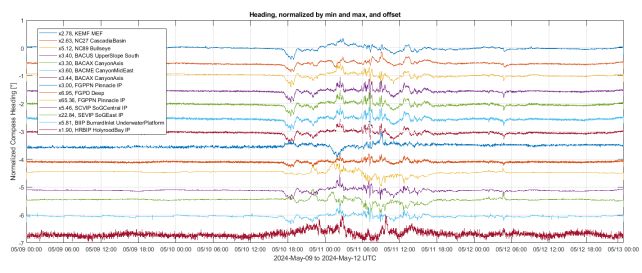ARTICLE AD
A solar storm that filled Earth's skies with shimmering curtains of light in May 2024 was so intense that its effects were felt, even at the bottom of the ocean.
Magnetic compasses used by Ocean Networks Canada (ONC) to help monitor the ocean off Canada's coast recorded a large and significant distortion in Earth's magnetic field as it was buffeted by a huge influx of particles ejected from the Sun.
It's a pretty amazing measure of precisely how powerful the storms were – but the data is valuable for other reasons, too. Firstly, we will now know what we're looking at when similar disruptions are recorded during future solar storms.
And secondly, the data can help scientists understand exactly how Earth is affected when one of these storms comes our way.
"The next two years will be the peak of the 11-year solar cycle. After a decade of relative inactivity, aurora events like this past weekend are likely to become more frequent over the next couple of years, although solar variability makes precise prediction of such events impossible," says physicist Justin Albert of the University of Victoria in Canada.
"ONC's network might provide a very helpful additional window into the effects of solar activity on the Earth's terrestrial magnetism."
Solar storms, also known as geomagnetic storms, are the things the Sun does that have the biggest effect on Earth. They occur when an eruption on the surface of the Sun ejects billions of tons of material tangled up with magnetic fields at high speed into the Solar System.
When this coronal mass ejection, or CME, arrives at Earth, the particles slam into our magnetic field, where a large number of them become entangled and accelerated until they are dumped out into our atmosphere. There, interactions with other particles cause the glowing aurora.
But that's not the only effect on Earth. Those interactions generate electrical currents that can cause surges that disrupt power grid fluctuations and disruptions. They can cause navigation, communication, and radio blackouts. And anything in near-Earth space is affected, too, like aircraft and satellites.
 Data from the ONC subsea compasses between May 9 and 12, showing a clear disturbance during the solar storm. (ONC)
Data from the ONC subsea compasses between May 9 and 12, showing a clear disturbance during the solar storm. (ONC)ONC has subsea observatories off the East and West coasts of Canada, at depths of up to 2.7 kilometers (1.7 miles). The compasses are primarily used to help orient the observatories' Acoustic Doppler Current Profilers (ADCP), which monitor changes in ocean currents. Their data needs to be checked daily to ensure quality control.
The Sun has been particularly active recently as it escalates towards solar maximum, the peak in its 11-year activity cycle, and ONC data specialist Alex Slonimer first noticed something odd in the compass data back in March, when we had some lovely geomagnetic storms.
"I looked into whether it was potentially an earthquake, but that didn't make a lot of sense because the changes in the data were lasting for too long and concurrently at different locations," Slonimer says. "Then, I looked into whether it was a solar flare as the sun has been active recently."
That seemed to track, so they decided to keep an eye on things. And, when powerful solar activity emerged from around May 10, the data once again went haywire. The most pronounced effect was on a compass 25 meters below sea level, off the coast of Vancouver Island in the Folger Passage. There, the needle skewed as far as +30 and -30 degrees.
This has the potential to be an excellent – if highly surprising! – new tool in the kit for understanding how solar outbursts affect our planet.
"The reach of these data recordings kilometers under the ocean surface," says ONC president Kate Moran, "highlight the magnitude of the solar flare over the past weekend and suggest that the data may be useful for better understanding the geographic extent and intensity of these storms."

 6 months ago
37
6 months ago
37 

